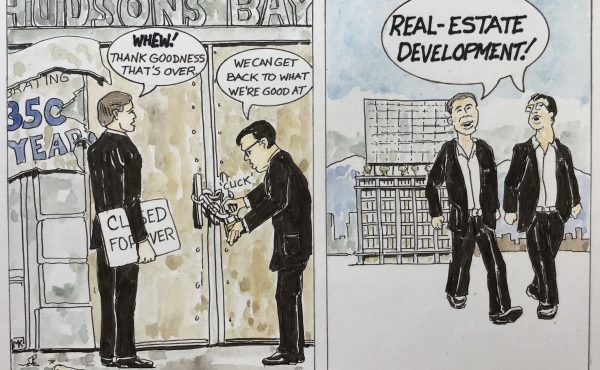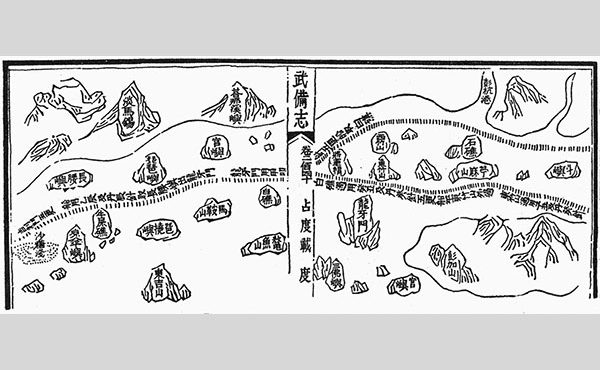Since last summer, Vancouver has been home to three performance artists who call themselves The Miss Guides – Natalie, Katherine, and Sean, also known as Dorian, anna swede, and Kidskid – have been using the downtown streets of Vancouver as their canvas, with the city’s storeys and their stories as their inspiration. Not to be confused with other walking tours, architectural or otherwise, regularly put on by the likes of the Gastown Business Improvement Society and Architecture Institute of B.C., a walk with The Miss Guides is a strolling theatre, an insightful performance of wit and revelation, with surprises for both the tourist and local alike.
Review by Sean Ruthen, re:place magazine
As a part of the Cultural Olympiad for the 2010 Winter Olympic Games, this trio of former VAG guides now turned performance artists have delivered to us another clever romp through Vancouver’s urban scenography. Much in the same spirit as last year’s Walking the Ruins: Fragments of Vancouver (and reviewed by re:place magazine here), GOLD RUSH! Art, Bars, and Speculation is a sequel to their former walk through Gastown, as we are led through the vanished meadows next to Maple Tree Square, regaled with stories of Gassy Jack (and Blood Alley), and led by the now sanitized Pigeon Park. Further on we visited Woodwards and Victory Square, reminded all the while that it was gold that paved the streets – or at least paid for the cobblestones. TMG are not without some subtle irony, as Team Canada likewise was on its quest for gold during the Olympics, and would strike it rich as it turns out.
This time out, however, our destinations were not as obvious as before, as the previous walk featured visits to the observation deck of the Harbourfront Centre and the Steam Clock. This time it is a clever behind-the-scenes bricolage, visiting one art gallery (W2) and another soon to be art gallery, as well as a visit to a stunning new artwork in an equally as impressive new public plaza on Hastings Street. If a soundtrack could accompany the Miss Guides walk, it most certainly would be the Wizard of Oz, as the song Somewhere Over the Rainbow is suggested to represent the hope of our destitute DTES. Scrubbed clean for the Olympics, Carrall and Hastings are a strange tourist destination for a visitor on any day, existential or otherwise, but as it turned out during the Olympics (and in the evening to boot), not as unnerving as I though it might.
With a bibliography this time including Italo Calvino and a citation from a 2009 National Geographic article entitled “The Price of Gold”, the Guides’ collage of modern and historic walking tours ranges from those most likely used by the Canadian Pacific Railway officials in the 1870’s to show around British land speculators, to current tours being given to Olympic officials and delegates. The performance this time out requires the added coordination of a narrative collage fed through each participant’s headsets during the walk. This served the important distinction of demarcating the group as an exclusive entity moving through the streets, discouraging panhandlers as we appeared ‘tuned out’ from the streetscape. The narratives themselves provided an audible palimpsest to the city’s visual imagery, featuring dialogue by the likes of Stephen Colbert and Colin Hansen.
 Two elements of GOLD RUSH stand out – the first is the aforementioned visit to the new artwork in Woodwards, the second being a visit to a printing press in one of the backrooms of the W2 gallery on Hastings Street. If last year’s Walking the Ruins was an epic poem, this year’s offering is an existential aphorism, like Nietzsche’s madman running through the streets, it is a wake-up call for those who have never seen life the way it is exhibited on the curbs of the Downtown Eastside. We are at once confronted with the city’s ghosts of the past, as represented by Gassy Jack and the cenotaph of Victory Square, along with the modern tragedy that is Hastings and Main, complete with homelessness and closed up businesses.
Two elements of GOLD RUSH stand out – the first is the aforementioned visit to the new artwork in Woodwards, the second being a visit to a printing press in one of the backrooms of the W2 gallery on Hastings Street. If last year’s Walking the Ruins was an epic poem, this year’s offering is an existential aphorism, like Nietzsche’s madman running through the streets, it is a wake-up call for those who have never seen life the way it is exhibited on the curbs of the Downtown Eastside. We are at once confronted with the city’s ghosts of the past, as represented by Gassy Jack and the cenotaph of Victory Square, along with the modern tragedy that is Hastings and Main, complete with homelessness and closed up businesses.
The artwork in question is of course the photo mural by Stan Douglas in the atrium of the newly opened Woodwards development, itself a symbol for the hopeful rebirth of the DTES. Nesters is back alongside a new London Drugs and the Arts Department of SFU, with the centerpiece belonging to Douglas’ masterpiece. The choice for Douglas to make this contribution was a no-brainer for those who know the sad story of the forlorn block adjacent to the long abandoned Woodwards. His Every Building on 100 West Hastings, also the subject of a book of the same name, was a watershed moment for the area, as the world bore witness to the devastation, social and otherwise, the closing of that department store had meant for the neighbouring buildings.
His impossible and literal photo montage of every building on the south side of the 100 block of Hastings Street, on display for a brief time at the CAG, and the resulting discussion that ensued, would become one of the many contributing voices needed to realize the new development, and hence the relevance of his contribution to the building’s great entry hall. For the mural’s subject matter, entitled A Night to Remember (or Forget), he has chosen the Gastown Riots that took place in 1971, an instance of local insurrection not unlike the Post Office Riots in 1938, otherwise known as Bloody Sunday, which the Miss Guides featured in their Ruins walk. Another coincidence is that part of the GOLD RUSH tour is to visit the upper floor spaces of the one of the building’s featured in Douglas’ Every Building on 100 West Hastings mural. Perhaps one of the most compelling images along the tour, the group visits a gallery in which, using the wizardry of digital projection technology, the Guides have lit the second and third floors of the building on fire.
Other highlights of the tour include the demonstration of an old printing press, a stop for tea in the bays of the old streetcar station at the corner of Carrall and Hastings, and a visit to a to-be-revealed location that provides the tour’s anchor to Gassy Jack and his old saloon ‘The Globe’. The headsets are a clever addition this time around, as the audio- imagery fills the gap between the tour’s stops. And the trips into the buildings, rather than just stopping in front to talk about them, elevates the performance to one of engagement with the environment, enabling us to literally enter into one of the abandoned storefronts in Douglas’ photo mural.
With tours running during the Winter Olympics in February, they are also offering them during the Paralympic Games, though unfortunately they have now all been sold out. Not to fear though, as they are sure to return post-Olympics to give us another chapter of their thoughtful and unique performance art.
For more information on The Miss Guides, visit their website.
By Sean Ruthen
***
Sean Ruthen is an architect living, working, and writing in Vancouver.




